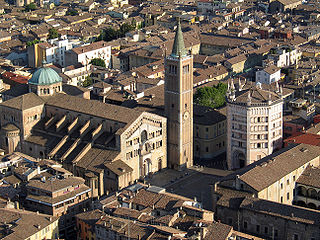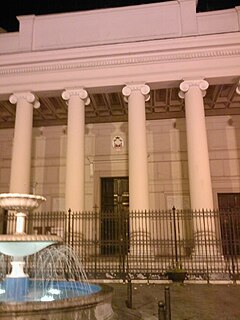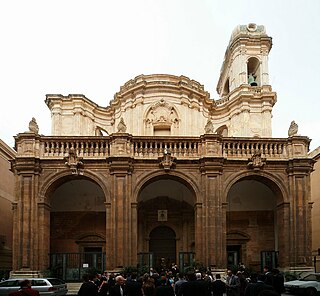
Parma Cathedral is a Roman Catholic cathedral in Parma, Emilia-Romagna (Italy), dedicated to the Assumption of the Blessed Virgin Mary. It is the episcopal seat of the Diocese of Parma. It is an important Italian Romanesque cathedral: the dome, in particular, is decorated by a highly influential illusionistic fresco by Renaissance painter Antonio da Correggio.

Assisi Cathedral, dedicated to San Rufino is a major church in Assisi, Italy. This stately church in Umbrian Romanesque style was the third church built on the same site to contain the remains of bishop Rufinus of Assisi, martyred in the 3rd century. The construction was started in 1140 to the designs by Giovanni da Gubbio, as attested by the wall inscription visible inside the apse. He may be the same Giovanni who designed the rose-window on the façade of Santa Maria Maggiore in 1163.

Genoa Cathedral or Metropolitan Cathedral of Saint Lawrence is a Roman Catholic cathedral in the Italian city of Genoa. It is dedicated to Saint Lawrence, and is the seat of the Archbishop of Genoa. The cathedral was consecrated by Pope Gelasius II in 1118 and was built between the twelfth century and the fourteenth century as fundamentally a medieval building, with some later additions. Secondary naves and side covers are of Romanesque style and the main facade is Gothic from the early thirteenth century, while capitals and columns with interior corridors date from the early fourteenth century. The bell tower and dome were built in the sixteenth century.

Macrino d'Alba was an Italian painter of the Renaissance period, active mainly in Piedmont, who is known for his altarpieces and portraits. His birth name was Gian Giacomo de' Alladio.

Padua Cathedral, or Basilica Cathedral of Saint Mary of the Assumption, is a Roman Catholic minor basilica and the cathedral located on the east end of Piazza Duomo, adjacent to the Bishop's palace, in Padua, region of Veneto, Italy. The cathedral, dedicated to the Assumption of the Virgin Mary, is the seat of the bishop of Padua. The church building, first erected as seat of a bishop of the diocese in the 4th century, has undergone major reconstructions over the centuries.

Fiesole Cathedral, or Cathedral of Saint Romulus of Fiesole,, officially the Cathedral of Saint Romulus of Fiesole, is a Roman Catholic cathedral in Fiesole, Tuscany, central Italy. It is the seat of the Bishop of Fiesole and is dedicated to Saint Romulus.

Pistoia Cathedral, or Cathedral of Saint Zeno is the main religious building of Pistoia, Tuscany, central Italy, located in the Piazza del Duomo in the centre of the city. It is the seat of the Bishop of Pistoia and is dedicated to Saint Zeno of Verona.

Faenza Cathedral is a Roman Catholic cathedral built in the style of the Tuscan Renaissance in central Faenza, Italy. It is the seat of the Bishop of Faenza-Modigliana and is dedicated to Saint Peter the Apostle.

Acerra Cathedral is a Roman Catholic cathedral in the town of Acerra in Campania, southern Italy, dedicated to the Assumption of the Virgin Mary.

Arezzo Cathedral is a Roman Catholic cathedral in the city of Arezzo in Tuscany, Italy. It is located on the site of a pre-existing Palaeo-Christian church and, perhaps, of the ancient city's acropolis.

Pescara Cathedral is a Roman Catholic cathedral in the Via D'Annunzio in the city of Pescara. The cathedral, dedicated to Saint Cetteus, patron saint of Pescara, has been the seat of the Archbishop of Pescara-Penne since the creation of the archdiocese in 1982. The present Romanesque Revival building, originally called the Tempio della Conciliazione, was constructed in the 1930s, replacing the medieval church of San Cetteo.
Paolo Cerrati (1485–1540) was a lawyer and Latin poet, best known for his long poem De Verginitate.

Grosseto Cathedral is a Roman Catholic cathedral in Grosseto, Tuscany, Italy. It is the cathedral of the diocese of Grosseto and is dedicated to Saint Lawrence.

Como Cathedral is the Catholic cathedral of the city of Como, Lombardy, Italy, and the seat of the Bishop of Como. It is dedicated to the Assumption of the Blessed Virgin Mary.

Teramo Cathedral is a Roman Catholic cathedral in Teramo, Abruzzo, central Italy, dedicated to the Assumption of the Virgin Mary and to Saint Berardo, patron saint of the city. It is the seat of the Bishop of Teramo-Atri. Built in Romanesque-Gothic style, it was consecrated in 1176.

Chioggia Cathedral is the main place of worship in Chioggia, Italy, in the south of the Venetian Lagoon. It dates from 1627. The interior contains many interesting works of art.

Fabriano Cathedral is a Roman Catholic cathedral in Fabriano, Italy, dedicated to San Venanzio. It is the seat of the Bishop of Fabriano-Matelica.

Avellino Cathedral is a Roman Catholic cathedral dedicated to the Assumption of the Virgin Mary and Saint Modestinus in Avellino, Campania, Italy. It is the seat of the bishops of Avellino.

Todi Cathedral is a Roman Catholic cathedral in Todi, Umbria, Italy, dedicated to the Annunciation of the Virgin Mary. It was formerly the seat of the bishops of Todi, and since 1986 has been a co-cathedral of the diocese of Orvieto-Todi.

Trapani Cathedral, otherwise the Basilica of St. Lawrence the Martyr is the cathedral of the Roman Catholic Diocese of Trapani, dedicated to Saint Lawrence. It is located in Trapani, Sicily, Italy.





















